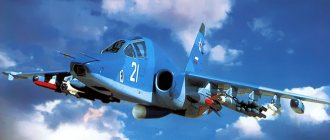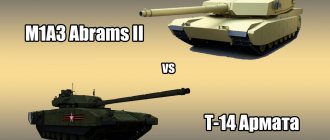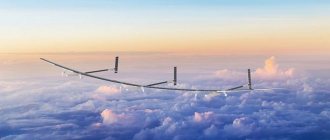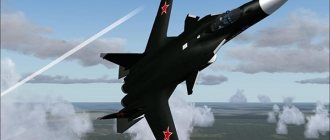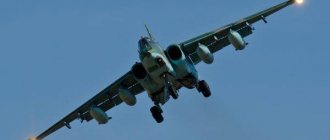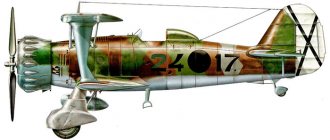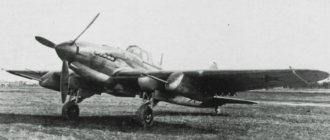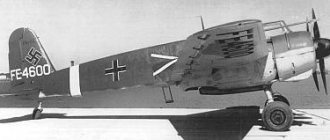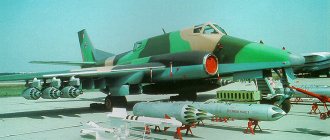Home » Real story » Aircraft of the present and future » Why does the Russian Aerospace Forces need a turboprop attack aircraft?
Aircraft of the present and futureAircraft of the present and future
boroda 01/22/2019 4016
12
in Favoritesin Favoritesfrom Favorites 8
The modern face of combat aviation is complex and expensive aviation systems. But along with such aircraft as the F-35 and PAK FA, there is now more and more talk about others - inexpensive but effective attack aircraft, created for “small” wars. Behind the modest appearance of these vehicles, great opportunities are hidden, and they do not plan to disappear from the arms market in the foreseeable future. Sukhoi Design Bureau design engineers Pavel Makarov and Andrei Stakhovich told the Zvezda TV channel about what future awaits them.
Small aircraft for big tasks
Oddly enough, in the modern world the prospects for turboprop attack aircraft are the highest, and this is dictated precisely by combat experience and demand on the international arms market. All countries of the world are interested in developing their own aviation, but many simply cannot afford 4th and especially 5th generation aircraft. At the same time, counter-guerrilla aviation makes it possible to simply and cheaply solve local problems of ensuring patrols, combating smuggling and terrorism.
It is important to note that currently no drone can fully solve these problems. Despite all the advantages, UAVs cannot be compared with manned aircraft in their strike potential. UAVs are reconnaissance and surveillance tools; they are excellent for one-time targeted strikes, but due to their limited carrying capacity, they are not capable of providing effective fire support during special operations or “pressing fire” on attacking militants, unlike counter-guerrilla aircraft.
In addition, as it turned out from the American experience of operating drones in the Middle East, the communication and data transmission channels of UAVs turned out to be vulnerable to interference and interception of the information they broadcast, and there are also problems with operators recognizing civilians and objects. In addition, the lightweight design and inability of attack and reconnaissance UAVs to perform sharp anti-aircraft maneuvers, combined with a narrow field of view of the camera and the presence of a delayed reaction to operator commands, make them very vulnerable even in the event of minor damage.
This, combined with a fairly high accident rate and high cost, makes the costs of replenishing the fleet of lost UAVs quite comparable to the costs of replenishing the fleet of manned aircraft.
US Air Force MQ-9 Reaper strike UAV
It is also important that anti-guerrilla aircraft can be used as training aircraft, since they can perform all the tasks of a basic training aircraft for flight schools. Moreover, due to lower fuel consumption per flight hour, their cost will be lower than that of jet training aircraft.
British Airspace Harrier fighter
The Harrier was a development of the Hawker vertical take-off technology demonstrator R. 1127, the development of a supersonic version of which (R. 1154) was discontinued. The Harrier remains the only Western combat aircraft in the world to have an engine with rotary nozzles. Initially viewed as an impractical novelty, it wowed its critics by providing enormous support during the 1982 Falklands War, combining technical reliability with accuracy and resistance to heavy enemy fire, while its naval cousin created an undeniable...
Read more
From World War II to Vietnam
The concept of counter-guerrilla aviation was born in response to the demands of the times and contrary to the forecasts of military analysts. At the end of the Second World War, a world political system was established with two distinct centers of power - the USA and the USSR. The global conflict did not have clear prospects for both sides. But even with the awareness of this fact, all participants in the process were preparing for a new war, developing more and more complex weapons.
But imperceptibly for everyone, the type of military conflicts changed: the war ceased to be massive and widespread - conflicts broke out in certain regions, where paramilitary (partisan) formations very often acted against army units. In such conditions, using aviation equipment developed for the “big” war to support the advancing ground forces turned out to be impractical, expensive and in some cases ineffective.
The US Air Force in Vietnam was the first to face the problem of supporting advancing ground army units. Jet aircraft created for the war with the USSR turned out to be ineffective for supporting the army in the jungle or striking an enemy using guerrilla tactics, and helicopters were not mobile enough and were too visible during military operations. In turn, the converted training aircraft turned out to be poorly protected from air defense fire.
At first (for example, during the Korean War), the problem was solved by “old stock” - aircraft that remained in service from the Second World War, for example, the A-26 Invader piston bombers and the A-1 Skyraider attack aircraft. These aircraft were designed for completely different purposes and did not meet the requirements of the military: combat losses and depletion of service life made their “leaving the scene” only a matter of time.
A-1 Skyraider in Vietnam
Under these conditions, several programs were launched in the USA and Europe to create specific attack aircraft, which in the USA were called COIN (Counter-Insurgency - counter-guerrilla or counter-guerrilla). The main idea of the program was that against small-sized and poorly protected targets, a light, cheap and multi-functional aircraft should be used, which can strike at “soft” (that is, poorly protected by air defense) targets, carry out patrols, and perform the functions of a light transport/communication aircraft , as well as various non-combat special tasks.
The result of these programs was a range of different combat vehicles to combat enemies poorly protected by air defense systems.
"LOCKHEED AC-130" - sky dreadnought
Fire support aircraft (USA)
The latest version of the AC-130U aircraft
The idea of a heavily armed sky battleship originated with the US Air Force in the early 1960s. The program was called "Ganship" (cannon ship) and began its implementation in 1965. The base for Ganship was the C-130 Hercules military transport aircraft, produced by . It was equipped with six-barreled machine guns, Vulcan rapid-fire cannons, a night vision system, an on-board computer and a radar station. And later they even installed a 105 mm howitzer!
Flight tests of the rearmed Hercules began in 1967. The first combat flight of the vehicle, which did not yet have an official name, but received the name “Vulcan Express” from the crew, took place on September 27, 1967. The winged monster in the blink of an eye turned a column of trucks coming from North Vietnam along the so-called Ho Chi Minh Trail to the aid of their South Vietnamese brothers into a pile of flaming debris.
Such a promising start prompted the US Air Force leadership to take a closer look at the new vehicle. And for good reason. After all, in 1970-1971 alone, “Ganships” destroyed about 12,000 units of Vietnamese military equipment! Our own losses were minimal due to the almost complete absence of air defense systems on the Ho Chi Minh Trail. Later, with their appearance, the flights of the Gunships had to be stopped. Since 1972, the name “Spectrum” has been assigned to the AS-130.
To protect against missiles with infrared homing heads, the AS-130 shoots false thermal targets
At the end of the 1970s, the “N” modification aircraft gained the ability to refuel in the air. Four of these vehicles hovered menacingly over the Iranian capital while American hostages were there. In 1983, during the US operation in Grenada, AC-130s suppressed enemy air defenses and allowed troops to land.
AC-130s took part in Operation Desert Storm, defeating a convoy of armored vehicles in the early days of the war, as well as in raids on Yugoslavia. None of the recent US campaigns could have gone without them: in 2001, Lockheeds bombed Afghanistan, in 2003 - Iraq, in 2011 - Libya. Today, the US Air Force is armed with 8 aircraft of the “H” modification and another 13 of the “U” modification, equipped with the latest on-board radar system.
The side of the AC-130U bristles with a 25-mm GAU-12/U cannon, a 40-mm Ml Boffors cannon and a 105-mm M-102 Howitzer howitzer.
Product of time
Until the early 1980s of the 20th century, the “locomotives” in the creation of attack aircraft to meet the requirements of the COIN program were the United States and France. France sought to maintain influence in its African colonies, the United States used these machines for local wars for its interests in the territory of other countries.
Gradually, for France, the relevance of creating such aircraft for its air force disappeared (the colonies were lost) - all the machines were discontinued and put out of service (for example, the Potez-75 counter-guerrilla aircraft, the T-28S Fennec trainer aircraft).
Potez-75
But the French, it seems, are not going to leave the market: in 2011, the French company ATE presented the Pulsatrix light reconnaissance and attack aircraft at the Le Bourget air show. The company expects that the project will attract the attention of states that do not have sufficient funds to purchase specialized light attack aircraft.
Light reconnaissance and attack aircraft Pulsatrix
In the United States, on the contrary, interest in counter-guerrilla aviation only intensified over time, and in the 1990s of the 20th century, a kind of boom in such aircraft began: over the next 20 years, several new aircraft were developed by private firms - A-22 Pirahna, Cessna AC- 208 Combat Caravan, V-1-A Vigilant, Scorpion, AT-802U, Archangel BPA, AT6-B.
Cessna AC-208 Combat Caravan
Cessna AC-208 Combat Caravan
One of the most famous aircraft created under the COIN program was the American attack aircraft OV-10 Bronco, which the Americans in Vietnam called a “workhorse.”
OV-10 Bronco
Fighter "Soko" "Orao" / CNIAR IAR-93
The Orao is a unique example of cooperation in the design of a military aircraft between countries on the other side of the Iron Curtain, made possible by Romania's special position in the Warsaw Pact and the communist beliefs of non-aligned Yugoslavia. The aircraft, produced in Yugoslavia as Soko Orao (Eagle), and in Romania as CNIAR IAR-93, was created jointly. In both countries, prototypes took off simultaneously (with a difference of several minutes) on October 31, 1974, followed by two two-seater aircraft, ...
Read more
Russian light attack aircraft
For a long time in the USSR, the military rejected the very idea of creating military equipment to fight partisan (liberation) forces, and the creation abroad of aircraft of this class was explained by the desire of capitalists to exploit and oppress captured colonies. The situation changed during the war in Afghanistan.
Just as in the United States, domestic military leaders came to the conclusion that the military equipment created was not fully suitable for this conflict. But even then, the concept of an anti-guerrilla aircraft (the military never introduced this classification into the official lexicon) did not find many supporters. And yet the work began - the first result was the Yak-52B aircraft (an attack modification of the Yak-52 training vehicle).
Yak-52B
The collapse of the USSR and subsequent transformations in our country put an end to all endeavors in this direction. Nevertheless, in the last decade of the 20th century, several interesting projects were created, such as, for example, aircraft from the Grunin Design Bureau . None of the samples went beyond flight prototypes, and some remained on paper. Light civil aircraft produced in the 1990s and 2000s, converted for patrol and strike missions, can be considered a partial implementation of the COIN concept in Russia.
For example, the Federal Border Guard Service of Russia ordered a small batch of SM-92P patrol aircraft, which are a modification of the SP-92 Finist civil aircraft armed with machine guns and bombs or NAR, to control the state border. But such aircraft have low survivability due to their relatively low flight speed and lack of protection and are a temporary solution on the “cheap and cheerful” principle.
SM-92P
The main burden of the fight against illegal armed groups in Russian aviation still lies on the shoulders of the gradually aging Su-25 attack aircraft and army aviation helicopters. But it should be noted that with a combat load comparable to anti-guerrilla aircraft, combat helicopters, due to their design features and lower speed, are an easier target for anti-aircraft fire, while having a higher cost.
In addition, the time spent by a turboprop attack aircraft in the target area, due to its significantly lower specific fuel consumption, can be many times longer than that of a helicopter or Su-25. An important factor is that the cost of a flight hour of a turboprop attack aircraft can be several times less than that of a combat helicopter or a jet combat aircraft when performing the same task.
Sukhoi Su-7 fighter
The outdated Su-7, although criticized for its low payload-to-range ratio, has excellent handling, low-altitude flight stability and maneuverability. Removed from service in the USSR, it is still retained in the air forces of 15 countries; the aircraft took part in combat operations in the Middle East and South Asia. First flown in 1955, it was adopted 4 years later as the Su-7B (NATO code Fitter-A) and quickly became the standard fighter-bomber of the Soviet air force.
Read more
One and a half tons of bombs and missiles
Analyzing the history of the creation of COIN class aircraft, we can distinguish three qualitatively different approaches to the creation of such aircraft. The first is the creation of a specialized attack aircraft from scratch. The advantage of this approach is the appearance of aircraft that fully satisfy customer requirements. The disadvantage is the high cost of development work and the deployment of mass production. Disadvantages also include the narrow specialization of machines.
The second approach is the modification of an existing light civil aircraft or training vehicle for military needs. The advantages of this method are the relative low cost of production, since “almost the same aircraft” is already being produced and in operation. Disadvantages: not always high performance characteristics and often low survivability.
The third approach is the creation of a multifunctional apparatus, one of the tasks of which is to fight an enemy poorly protected by air defense systems. The advantages of this approach lie in both compliance with customer requirements for an attack aircraft and a large area of its application for both military and civilian purposes (for example, in the initial training of pilots). The disadvantages include higher cost than in the second approach.
Combat experience has shown that such an aircraft should have a maximum speed of no more than 700 kilometers per hour, and an operating speed of no more than 300–400 kilometers per hour (otherwise the pilot will lack time to aim). The aircraft must have armor protection for the cockpit and the most important parts of the structure from small arms fire, and modern means of countering MANPADS.
Depending on the task, it should be able to use a wide range of guided and unguided weapons with a combat load of 1000–1500 kilograms, and also have a turboprop engine as a power plant as it is more economical than a turbojet and has lower IR visibility. range.
Fighter "Dassault-Breguet" "Mirage" 5 and 50
Responding to an Israeli proposal, it created a simplified (and therefore cheaper) version of the highly successful Mirage III aircraft, the Mirage 5, which made its first flight on May 19, 1967. It was optimized as a day bomber and interceptor and had no some components of its predecessor, the Mirage IIIE, most notably the nose-mounted Cyrano II radar (replaced by a radio range finder), as well as other avionics. Having maintained the speed corresponding to the number M=2, and the ability...
Read more
IL-2 armament
| Two guns | • 20 mm SHVAK; • Or 23 mm VYa; • Or 37 mm anti-tank version (unsuccessful experiment due to high recoil and low accuracy); • Or 45 mm at testing stage. |
| Two machine guns | Located on the wings of ShKAS |
| Air bombs | Jet: • RS-82; • RS-132. |
| Defensive machine guns | Only the two-seat versions of the Il-2 were equipped with a 12.7 mm UBT machine gun |
But the reduction in cost and reduction in production time also affected these machines.
As before, the wings and tail of attack aircraft were made of wood. Therefore, high losses of Il-2 aircraft persisted for a very long time.
Having higher speed and maneuverability characteristics, German fighters easily escaped the kill zone and attacked the vulnerable spots of the Soviet “flying fortresses”.
Shenyang J-6 fighter
MiG-19 aircraft in the late 1950s. ceased production in the USSR, but continued to be produced in China under a license agreement concluded in January 1958. The J-6 (Type 6 fighter) is usually believed to be produced by a plant in Shenyang, but there is also a second assembly line in Tianjin. The first model produced in China, the J-6, was the day fighter equivalent of the MiG-19S, followed by the limited all-weather interceptor J-bA/MiG-19P, and then the -1-6V/MiG-19PM, with reinforced cannon armament and air-to-air missiles. air" AA-1 "Alcoli". Improved...
Read more
Fighter "McDonnell Douglas" F-15E "Advanced Eagle"
Introduced as a highly effective interceptor, the F-15 Eagle was modified in 1980 into an all-weather aircraft capable of hitting targets without entering the air defense zone. This version, created at the initiative of the company, was first called the Strike Eagle, and later, when the US Air Force showed interest in it and tested it between November 1982 and April 1983, it was renamed the F-15E. Improved Eagle." Along with the F-16E, the Advanced Eagle competed in the US Air Force's competition for an aircraft capable of...
Read more

